mobile Ansicht, to the English Version tap the flag
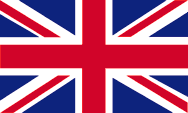

- Autonome Region Spaniens
- 13. bis 15. Jhd. Königreich Kastilien-Leon
- Eigenbezeichnung:
– Spanisch: Castilla y León
• Flagge
• historische und andere Flaggen
• Bedeutung/Ursprung der Flagge
• Wappen
• historische Wappen
• Bedeutung/Ursprung des Wappens
• Landkarte der autonomen Regionen Spaniens
• Landkarte der historischen Königreiche auf der Iberischen Halbinsel
• Zahlen und Fakten
• Geschichte
• Ursprung des Landesnamens
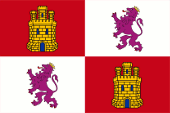
seit 1980,
Flagge von Kastilien-Leon,
Seitenverhältnis = 2:3,
Quelle, nach: Flags of the World






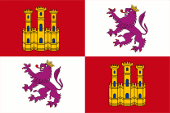
1230–1479,
Flagge des Königreichs Kastilien-Leon,
Quelle, nach: Wikipedia (DE)





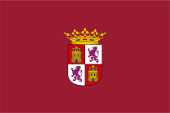
1978–1980,
Flagge von Kastilien-Leon,
Quelle, nach: Wikipedia (DE)




Die heutige Flagge der spanischen autonomen Gemeinschaft Kastilien und León wurde am 25.02.1983 per Gesetz eingeführt. Sie zeigt das Design der Flagge des alten Königreichs Kastilien-Leon, das bis 1479 bestand. Die Flagge des alten Königreichs Kastilien-Leon war, wie damals üblich, eine Wappenflagge. Das heißt, eine Flagge die das Bild des Wappens des Landes (eigentlich des Herrschers) zeigte. Das Flaggentuch ist gevierteilt und zeigt eine Kombination der Heraldik von Kastilien und von Leon: Burg und Löwe. Dieses Design entstand im Jahre 1230 durch die Vereinigung der Kronen beider Länder. Durch die Gründung des spanischen Staates im Jahre 1479 rückte die Symbolik des Königreichs Kastilien-Leon in den Hintergrund. Natürlich erschienen Burg und Löwe über die Jahrhunderte in immer wieder anderer Gestalt, dem Zeitgeschmack unterworfen, denn Vorgaben oder Vorschriften über die exakte Ausführung der Bilder gab es damals noch nicht. Das heutige Erscheinungsbild steht jedoch seit 1983 fest. Unter der der Regierung des Generals Franco (1936–1975) waren jedoch alle regionalen Flaggen verboten. Nach Francos Tod (1975) wurden die regionale Flaggen eingeführt oder wieder eingeführt. Im Jahre 1978 führten Neukastilien (Kastilien-La Mancha) und Altkastilien (Kastilien-Leon) eigene Flaggen ein, wenn auch zunächst inoffiziell, da beide Länder bis 1982/83 noch keinen Autonomiestatus hatten. Die Macht und Kultur von Kastilien-Leon prägten ganz Spanien über Jahrhunderte. Besonders seit den 70-er Jahren des 20. Jahrhunderts besannen sich aber alle Bestandteile des spanischen Staates ihrer eigentlichen kulturellen Herkunft und entwickelten Autonomiebestrebungen, die eigentlich eine Bewegung weg vom dominierenden Kastilien war. So wurde 1978, vor dem heutigen Modell, zunächst eine andere Flagge eingeführt. Sie ging auf ein Banner aus dem 16. Jahrhundert zurück, war einfarbig purpur und trug das Wappen des Landes in der Mitte. Schon um 1980 besann man sich in Kastilien-Leon seiner Tradition und reaktivierte die ursprüngliche Symbolik von Kastilien-Leon aus dem 15. Jahrhundert. Die einfarbig purpurne Flagge gilt jedoch bis heute als Banner des Landes.
Quelle:
Wikipedia (DE),
Flags of the World,
Volker Preuß

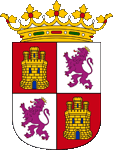
seit 1978,
Wappen von Kastilien-Leon,
Quelle, nach: Heralder],
some elements by Rastrojo, CC BY-SA 3.0, via Wikimedia Commons

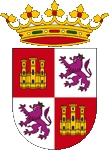
ab 13. Jahrhundert,
Wappen der Grafen von Barcelona,
Quelle, nach: Wikipedia (DE), Flags of the World

Das heutige Wappen der spanischen autonomen Gemeinschaft Kastilien und León wurde für die Region wahrscheinlich 1978 wiedereingeführt und am 25.02.1983 per Gesetz bestätigt, als die autonome Gemeinschaft gegründet wurde. Es zeigt das Design des Wappens des alten Königreichs Kastilien-Leon, das bis 1479 bestand. Es war gevierteilt und zeigte eine Kombination der Heraldik von Kastilien und von Leon: Burg und Löwe. Dieses Design entstand im Jahre 1230 durch die Vereinigung der Kronen beider Länder. Natürlich erschienen Burg und Löwe über die Jahrhunderte in immer wieder anderer Gestalt, dem Zeitgeschmack unterworfen, denn Vorgaben oder Vorschriften über die exakte Ausführung der Bilder gab es damals noch nicht. Das heutige Erscheinungsbild steht jedoch seit 1983 fest.
Quelle:
Wikipedia (ES),
Volker Preuß

Die autonomen Regionen Spaniens:
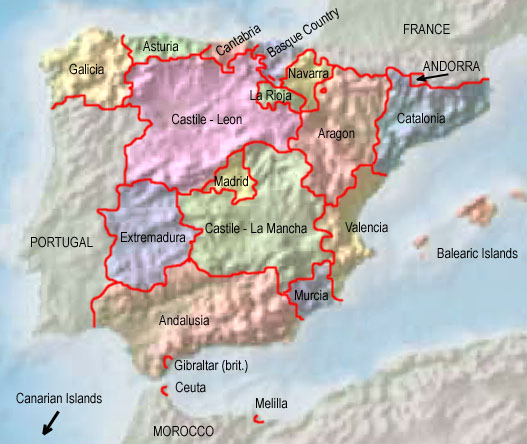
Quelle/Source: Freeware, University of Texas Libraries, modyfied by: Volker Preuß

Karte der historischen Königreiche auf der Iberischen Halbinsel (ca. 1220):
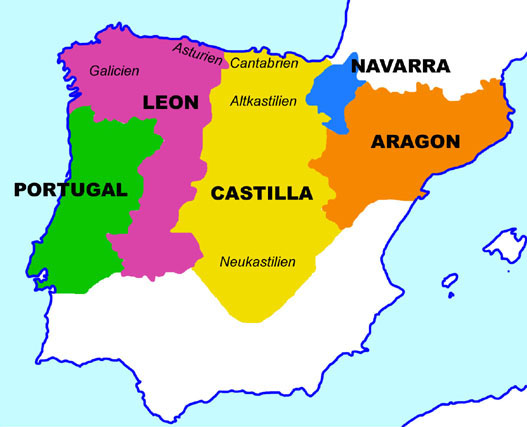
Landkarte/Map: Volker Preuß

Fläche: 94.223 km²
Einwohner: 2.372.495 (2022), meist Kastilier, auch Leonesen
Bevölkerungsdichte: 25 Ew./km²
Hauptstadt: Valladolid, 295.639 Ew. (2022)
Amtssprache: Spanisch (Kastilisch)
sonstige Sprachen: Leonesisch
Währung: spanische (Euro-)Währung
Zeitzone: MEZ
Quelle: Wikipedia (DE)

Das Königreich Kastilien-Leon entstand im Jahre 1230 durch die Vereinigung der Kronen der beiden Königreiche Kastilien (← hier klicken) und Leon (← hier klicken). Kastilien wurde der wichtigste und Hauptbestandteil des Königreichs Kastilien-Leon.
1230–1252 · Herrschaft von König Ferdinand III. (der Heilige), sehr erfolgreiche Kämpfe im Befreiungskrieg gegen die Araber, Ausdehnung von Kastilien-Leon bis an die Südküste Spaniens im Atlantik und Mittelmeer
1236 · Befreiung von Córdoba von den Arabern, Gründung des Kastillischen Königreichs Córdoba
1243 · die Stadt Murcia wird durch Alfons X. von Kastilien und seinen Truppen von den Arabern befreit, Gründung des Kastillischen Königreichs Murcia
1248 · Befreiung von Sevilla von den Arabern, Gründung des Kastillischen Königreichs Sevilla
1248 · Befreiung von Cartagena von den Arabern
1252–1284 · Herrschaft von König Alfons X. (der Weise), Sohn von Ferdinand III., Thronfolgestreitigkeiten zwischen seinen Söhnen Ferdinand (Erstgeborener) und Sancho (Zweitgeborener)
1284–1295 · Herrschaft von König Sancho IV. (Sohn von Alfons X.), Adelsrevolten
1295–1312 · Herrschaft von König Ferdinand IV. (Sohn von Sancho IV.), Adelsrevolten, Angriffe der benachbarten Königreiche, die Regentin Maria de Molina (Mutter des minderjährigen Ferdinand IV.) kann Kastilien-Leon bewahren
1312–1350 · Herrschaft von König Alfons XI. (Sohn von Ferdinand IV.), Adelsrevolten, Machtkämpfe, Angriffe der benachbarten Königreiche, Bürgerkrieg
1344 · Befreiung von Algeziras von den Arabern
1350–1369 · Herrschaft von König Peter dem Grausamen (Sohn von Alfons XI.), finstere Herrschaft voller Grausamkeit und Greueltaten, Aufstände, Revolte seines Halbbruders Heinrich von Trastamara
1369 · Schlacht von Montiel, König Peter wird von Heinrich getötet
1369–1379 · Herrschaft von König Heinrich II. (Halbbruder von Peter dem Grausamen), Thronstreitigkeiten mit Peters Schwiegersohn Johann von Lancaster
1379–1390 · Herrschaft von König Johann I. (Sohn von Heinrich II.), Krieg gegen Portugal und das englische Haus Lancaster
1387 · Vertrag von Bayonne, Friede mit England
1389 · Friede mit Portugal
1390–1406 · Herrschaft von König Heinrich III. (Sohn von Johann I.), auf Grund von Minderjährigkeit zunächst unter einem Regenten, daher Schwierigkeiten in der Verwaltung des Reiches
1393 · König Heinrich III. erklärt sich für mündig, Heirat mit Catharine von Lancaster
1402 · Inbesitznahme der Kanarischen Inseln durch Kastilien-Leon
1406–1454 · Herrschaft von König Johann II. (Sohn von Heinrich III.), auf Grund von Minderjährigkeit zunächst unter einem Regenten
1439 · Unruhen, Aufstände
1454–1474 · Herrschaft von König Heinrich IV., dem Ohnmächtigen, (Sohn von Johann II.), Erbfolgeprobleme, Aufstände, Adelsrevolten
1462 · Befreiung von Gibraltar von den Arabern
1465 · Aufstände, Adelsrevolte, der Adel ernennt Alfons, den 11-jährigen Bruder von Heinrich IV. zum König, Bürgerkrieg
1468 · Tod von Alfons, der Adel proklamiert Isabella, die Schwester von Heinrich IV. zur Königin (Isabella I.)
Im Jahre 1469 heiratet Isabella I., Königin von Kastilien-León Ferdinand II., den Prinzen und Thronfolger von Aragónien. Beide werden 1479 zu Königen von Spanien gekrönt, und somit Kastilien-Leon und Aragónien zu einem einzigen Land vereinigt. Das mächtige und alte Kastilien wird damit zum Hauptbestandteil Spaniens und wird prägend für die spanische Kultur.
11.12.1474 · Tod von Heinrich IV., Ende des Bürgerkriegs, Isabella I. wird als Erbin von Kastilien-Leon bestätigt, Portugal erhebt Ansprüche auf den Thron, Krieg Portugals und Frankreichs gegen Kastilien-Leon
1476 · Schlacht bei Toro, Niederlage der Portugiesen
1479 · Friede von Alcantara, Portugal erkennt Isabella als Königin von Kastilien-Leon an
1479 · Tod von König Johann II. von Aragonien, Nachfolger ist Ferdinand II., Gemahl von Königin Isabella I., Vereinigung der Kronen von Aragonien und Kastilien-Leon, Krönung von Ferdinand II. und Isabella I. zu Königen von Spanien
1492 · Eroberung des Emirats von Granada durch Spanische Truppen, damit Beseitigung des letzten Brückenkopfes der Araber auf Europäischem Gebiet, Christoph Columbus entdeckt Amerika, Beginn des spanischen Kolonialzeitalters, Aufstieg Spaniens zur Weltmacht
1808–1813 · Kastilien ist durch französische Truppen besetzt
1833 · die bis dato in Spanien bestehenden Teilkönigreiche und Regionen werden in Provinzen aufgeteilt, auch Altkastilien und Leon, und zwar in die Provinzen León, Zamora, Salamanca, Palencia, Burgos, Logroño, Valladolid, Avila, La Granja und Soria
1936–1939 · Spanischer Bürgerkrieg, Alt-Kastilien und Leon (das heutige Kastilien-Leon) kämpft an der Seite der Franco-Truppen gegen die sozialistische Zentralregierung, Neu-Kastilien (das heutige Kastilien-La Mancha) kämpft teilweise und vereinzelt bis 1939 auf Seiten der sozialistischen Regierungstruppen
25.03.1983 · Kastilien-Leon erhält das Autonomiestatut innerhalb Spaniens (unter Zusammenfassung der Provinzen León, Zamora, Salamanca, Palencia, Burgos, Valladolid, Avila, La Granja und Soria), Gründung der "Autonomen Gemeinschaft Kastilien und Leon"
Quelle: Wikipedia (ES),
World Statesmen,
RetroBib Retrobibliothek,
Volker Preuß

Der Name "Kastilien-Leon" ist eine Kombination der Namen der beiden Regionen "Kastilien" und "Leon".
Quelle: Volker Preuß


![]()














